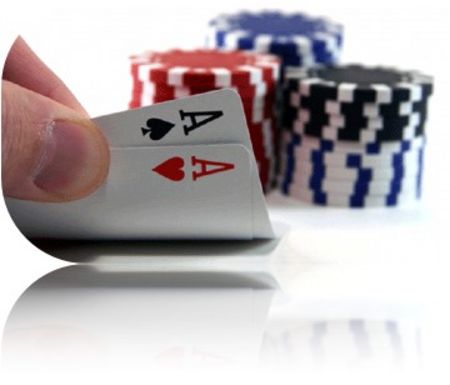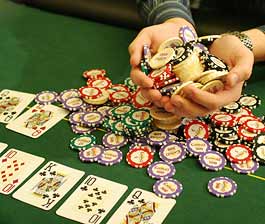The Blinds

You will lose money in the blinds no matter how good you are. You are forced to
pay the blind money with many poor hands that you will be folding a lot. Your goal
is to minimize your losses; however, many players lose more than they should by
playing too many weak hands.
Play in the blinds is very subjective and dependent on many factors. It is here more
than any other position that your post-flop play is critical. Calling a raise with KJ
might be OK for some players, but only if you know how to play the hand well after
the flop. It takes a lot of experience to be able to play weak hands profitably out of
position. It is recommended that beginning and intermediate players play
conservatively from the blinds. In the following discussions, we will assume that
there is at least one opponent in the hand other than the small blind and big blind.
There is a separate section that discusses play when everyone has folded to the
blinds.
Unraised Pots
You should almost always raise with AA, KK, QQ, AKs, and AK. If there are only
one or two callers, you can also raise with AQs and AQ. Against one limper you can
also raise JJ. When you are in the small blind, you can raise one limper with more
hands such as TT, 99, AJs, AJ, ATs, and AT. You probably have the best hand and
you would usually like the big blind to fold to isolate yourself against a lone
opponent.
When calling a half bet from the small blind, you can play many hands since you
are getting good pot odds on a half bet; however, you still need to be somewhat
selective since you will be acting first on every round. As usual, the hands you
should play depend a lot on the number of callers:
One caller: pairs, two cards T and above, two suited 8 and above, Ax Kxs T9 87s
76s
Two callers: 98 97s 65s 54s
Three callers: Qxs J7s T7s 87 86s 76 75s 65 64s
Four callers: 96s 85s 54 53s 43s 32s
One note about the limit you are playing. In most limits, the small blind is half the
amount of the big blind: however, in some limits this amount could be more or less
than half, so you seed to adjust accordingly. For example, in a $15-$30 game, the
small blind posts $10, which is 2/3 the amount of the big blind. You can play a few
more hands since the cost of calling is only 1/3 of a bet. On the other hand, if you
are playing $5-$10 and the small blind is only $2, you should be more conservative
with the hands you play since the cost of playing is now 3/5 of a bet.
Raised Pots
When the pot has been raised, there are several considerations in determining your
best strategy:
-
What position did the raise come from? An early position raiser usually has a
premium hand, so you should be selective with the hands you decide to play.
A late position raiser could be trying to steal the blinds, so you can play more
hands.
- How many total players are in the pot? The more players in the hand, the
better your pot odds since you only owe one or one and a half small bets to
play.
- Were there any cold callers? There is a big difference in a player who limps
and then calls a raise versus a player who cold calls a raise. If there is an
early position raiser and a middle position caller, you should proceed very
carefully, especially with the trap hands. Compare this to a middle position
limper and late position raiser. In this scenario you could call a few more
hands.
- Will your call close the betting? Some players like to slowplay their premium
hands from early position hoping to be able to reraise. If this type of player
has called from early position and another player raises, you should fold
more often than otherwise for the risk of a reraise and possibly even a
capped pot.
- What type of player is the raiser? Is he a rock who never raises without a
premium hand? Is he a loose aggressive player who tends to overplay his
hands post-flop once he has raised? Does the player try to steal the blinds a
lot? With some players, you can narrow down their hands to the top premium
hands, while other players might be raising with almost anything. Always
consider the type of opponent you are against on borderline decisions.
When you are in the big blind and the pot has already been reraised, go ahead and
cap with AA, KK, and sometimes QQ. Only call a reraise with the premium hands:
JJ, AKs, AK, AQs, AQ, and AJs.
Against a raise, you should only reraise with the very best premium hands: AA, KK,
QQ, and AKs. You can also reraise with AK, although sometimes you might just call
against several opponents.
When you are in the small blind against a raiser, you should reraise with a few more
hands to isolate yourself against one or two players. Generally reraise with AQs
and AQ against one or two opponents, but call against three or more. Against a
lone raiser, go ahead and reraise with JJ, TT, and 99. If you are against a lone late
position raiser, you should almost always reraise if you play your hand. These
hands include 88, 77, AJs, AJ, ATs, AT, and A9s. You can consider reraising with
KQs or KJs depending on the type of opponent you are against, although you might
just call if there is a weak opponent in the big blind.
Let's look now at calling raises from the big blind against a lone opponent. In these
cases, the position and type of opponent is very important. Generally fold the small
pairs against a lone opponent. Consider calling 88 and 77 against a lone middle or
late position opponent and 66 or 55 against a late position opponent; otherwise, you
probably should fold these hands. Other hands to consider calling against a lone
early or middle position raiser include: TT, 99, any two suited T and above, AQ, AJ,
AT, Axs, KQ, K9s, QJ, and QT. Against a lone late raiser, you can add A9, A8, KJ,
KT, Q9s, and Q8s.
Against two or more opponents, you can usually call from the big blind with any
pair, two cards ten and above, Q9s, Q8s, J9s, T9s, and 98s; however, be careful
with the unsuited trap hands like KJ, KT, and QT. These hands are often
counterfeited against several opponents in a raised pot, especially when there is an
opponent who has cold-called a raise. You need to know when to fold these hands
on the flop if you are going to play them profitably.
With more opponents you can play more hands from the big blind:
Three: Kxs Qxs J8s T9 T8s 98 97s 87s 76s 65s
Four: T7s 87 86s 76 75s 54s
Five: J7s 96s
When you are in the small blind, you still need a strong hand to call against several
opponents since you must call 3/4 of a bet and you have to act first on every betting
round. Against two opponents you can call with JJ, TT, 99, AJs, ATs, and KQs.
Against three opponents you can play all pairs. Against four opponents you can add
KJs, QJs, and JTs. Finally, consider calling T9s and 98s against five or more
opponents. Note that even a hand like KQ should almost always be folded against a
raise when you are in the small blind.
Small Blind vs. Big Blind
Players who play mostly in live games often do not have a lot of experience playing
hands when everyone folds to the blinds. Many casinos allow the players to "chop,"
where each player simply takes back their blinds rather than playing out the hand.
Internet Tip
 If you play mostly in live games and begin to play online, it is essential to learn to play well in small
blind versus big blind situations, especially in the higher limits.
If you play mostly in live games and begin to play online, it is essential to learn to play well in small
blind versus big blind situations, especially in the higher limits.
Small blind versus big blind situations still do not occur very often full ring games at
the lower limits since usually there are sever callers in each hand. However, in the
higher limits and in short-hand-ed games, advanced players can earn a lot of
money in this situation against the right opponents.
Everything changes when everyone folds around to the blinds. First of all, the big
blind now has positional advantage over the small blind. On the other hand, the
small blind only has to call a half a bet and beat only one opponent. In these heads-
up situations, it is difficult to define starting hand guidelines since strategies are
very dependent on the type of opponent you are against and your table image.
When you are in the small blind, you are getting 3 to 1 pot odds on a call, but at the
same time will be acting first on every betting round. Your strategy to fold, call, or
raise is dependent on several factors:
- Does the big blind defend his blinds appropriately? If he folds too much, you
should raise with a lot of hands.
- Does the big blind play his hands aggressively preflop? What are the
chances of being raised if you just call half a bet? If the big blind is
aggressive, you will need to limit your calls since you may have to pay a high
price for a mediocre hand out of position. By the way, if you call with a weak
hand, feel free to fold if the big blind raises. This is one case where calling
and then folding preflop can be correct since the pot is small, you are out of
position, your opponent has indicated strength, and your hand is not very
strong.
- How does the big blind play post-flop? Play more hands against opponents
who make a lot of mistakes after the flop.
The following guidelines are for hands against typical players, but these can change
dramatically depending on the type of opponent you are against and the conditions
discussed above. In the small blind, you can safely raise with all pairs, any two
cards jack and above, ATs, AT, KTs, KT, and QTs. Generally you can call with any
two cards 8 and above, any two suited cards 7 and above, Ax, Kx, and Qxs;
however, you should fold many of these hands if you are raised. Against weak
opponents you could raise or call with even more hands.
When you are in the big blind against the small blind, you should generally play
aggressively. If the small blind raises, generally reraise with all the hands you would
raise with from the small blind: all pairs, any two cards jack and above, ATs, AT,
KTs, KT, and QTs. You can call a raise with all of the hands you would normally call
with from the small blind. If the small blind is a rock, you will need to be more
conservative with the hands you reraise or call with.
If the small blind just calls, raise with many hands. The small blind has indicated
weakness, and you have good position, so take advantage of it! Most players can
safely raise with all the following hands: any pair, two cards ten and above, Ax, and
K9(s). Again, you can raise with even more hands against weak opponents who
play poorly after the flop.
Internet Tip
If you follow the starting hand guidelines in this chapter, you should be playing fewer hands than
most of your opponents. Patience is a virtue in this game. Fortunately, it is much easier to be patient
on the Internet than in a live game. In a live game, the action is much slower and your patience can
sometimes run thin if you get a bad run of cards. On the Internet, you can play over 70 hands an
hour even in a full ring game, Stay patient and you will get plenty of chances to play sonic strong
hands.
NEXT...Review

